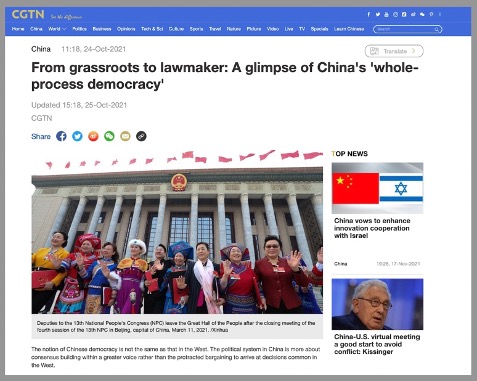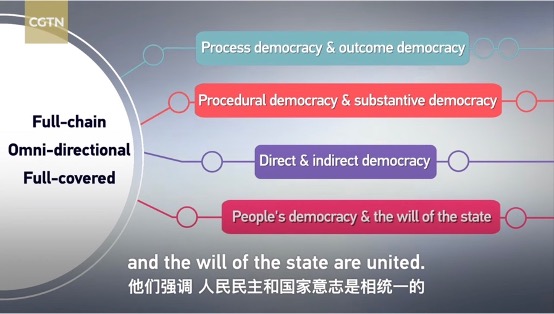China’s National People’s Congress meets in April 1959. Image in the public domain available at Wikimedia Commons.
“Whole-process democracy” has since come to encompass the idea that China’s one-party political system is a unique “application of democratic principles” that is in fact more participatory than democratic systems in the West, which state media in the PRC now frequently insist focus only on electoral cycles and fail to consistently respond to the needs of the people. The West is mentioned frequently in coverage of “whole-process democracy” by the Party-state media, suggesting that the idea has been introduced to make the case before domestic audiences for the strength of China’s political system, as well as to throw off criticism internationally of China on human rights grounds.
The phrase was used prominently to make this contrast during Xi Jinping’s November 15, 2021, video call with US President Joe Biden. As Biden sought to frame confrontation between China and the US as being about the broader struggle between autocracy and democracy, Xi pushed back with his framing around “whole-process democracy,” essentially arguing that China has found a democratic system distinct from “that in the West.” According to Xinhua News Agency:
Xi Jinping stressed that civilization is rich and abundant, and so is democracy. Democracy is not a customized product (定制的产品), with one model for the whole world, and one standard. Whether a country is democratic or not is to be judged by the people of that country themselves. To exclude different forms of democracy simply because they are different is itself undemocratic behavior. We are willing to conduct dialogue on human rights issues on the basis of mutual respect, but we do not support the use of human rights issues to interfere in the internal affairs of other countries.
In October 2021, CGTN said in an English-language report on “whole-process people’s democracy” that it enabled the Chinese people to “broadly and continuously participate in the day-to-day political activities at all levels, including democratic elections, political consultation, decision-making and oversight.”

Up to November 18, 2021, the phrase “whole-process people’s democracy” had appeared in a total of 129 articles in the People’s Daily, all but one of these coming after July 1, 2021, and Xi Jinping’s speech to commemorate the centennial of the CCP, in which he said “we must rely closely on the people to create history, adhering to the fundamental mission of wholeheartedly serving the people. . . . developing whole-process people’s democracy.”
While the notion of a “whole-process” is a new way to describe the relationship of the people to governance under socialism with Chinese characteristics, the term “people’s democracy” is much older, rooted in Marxism-Leninism as it emerged after the Second World War. The phrase is related to the concept of the people’s democratic dictatorship (人民民主专政), included in the Preamble to the PRC Constitution, as “led by the working class and based on an alliance of workers and peasants.” In this sense, the idea of a “people’s democracy” essentially means that the CCP and the state represent and run affairs on behalf of the people.
During the Central National People’s Congress meeting (中央人大工作会议) in October, President Xi said “whole-process people’s democracy” was about ensuring that the “people are the masters” (人民当家作主). The measure of how democratic a country is, said Xi, hinges on “whether or not it truly enacts the people as the masters.” This was the purpose, he said, of “people’s democracy”:
People’s democracy is whole-process democracy, [in which] all major legislative decisions proceed according to procedures, going through democratic fermentation, and arising from scientific decision-making and democratic decision-making.
In his speech, Xi employed several permutations of the phrase, including:
全过程人民民主
全过程民主
全过程的民主
President Xi further elaborated “ whole-process democracy” as combining four paired aspects of democracy, including 1) “process democracy” (过程民主) and “achievement democracy” (成果民主), 2) “procedural democracy” (程序民主) and “substantive democracy” (实质民主), 3) “direct democracy” (直接民主) and “indirect democracy” (间接民主), and 4) “people’s democracy” (人民民主) and the “will of the state” (国家意志). This set of relationships, which Xi said resulted in “real and effective socialist democracy,” has been promoted actively by the Party-state media, including in a video report by corporate strategist Robert Lawrence Kuhn that mouthed state talking points verbatim.


Stella Chen
The CMP Dictionary
C
D
F
G
M
N
P
S
- Scaling the Wall
- Science
- Second-Generation Reds
- Security
- Seeking Progress in Stability
- Self-Revolution
- Seven Bottom Lines
- Six Adheres
- Smart Governance
- Sneaky Visit
- So-Called
- Socialite
- Soft Resistance
- Soul and Root
- Soundless Saturation / Quietly Nourishing
- Sovereignty
- Speaking Politics
- Streamlining Services
- Strong Cyber Power

